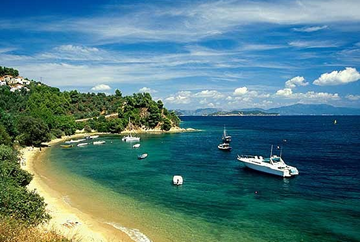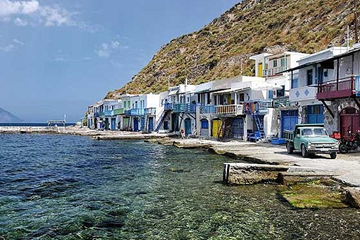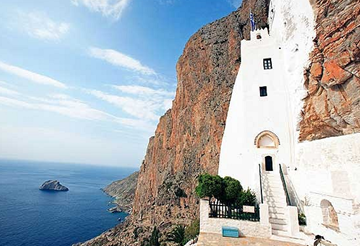Every publisher's nightmare? Or every reader's dream? When the publisher Blue Guides asked Nigel McGilchrist, an art historian, to write a guide to the Greek islands, it never expected what it got – a manuscript that ran to nearly 600,000 words, three times the agreed length. McGilchrist's enthusiasm for his subject, which he researched for the best part of six years, was like a runaway horse.
 The 53-year-old scholar, who has lectured on both sides of the Atlantic, lives in solitary splendour in Italy, in a farmhouse near Orvieto. In the great tradition of eccentric English expats, he keeps donkeys, produces his own olive oil and aspires to the philosophical mellowness of the Roman poet Horace. But the opportunity to write about his beloved Greece – he studied classics at Oxford – was too good to miss.
The 53-year-old scholar, who has lectured on both sides of the Atlantic, lives in solitary splendour in Italy, in a farmhouse near Orvieto. In the great tradition of eccentric English expats, he keeps donkeys, produces his own olive oil and aspires to the philosophical mellowness of the Roman poet Horace. But the opportunity to write about his beloved Greece – he studied classics at Oxford – was too good to miss.
"I was commissioned to write the book at the start of 2003 and delivered the manuscript in late 2008," he says. "For a time, the project took over my whole life. But I was relishing the challenge. There was just so much to cover."
At the height of his research, he was visiting the Aegean all year round, in the dog days of winter as well as in the heat of high summer. He traipsed from archaeological site to archaeological site. He could hardly find a secluded beach or friendly taverna without making a note of it. He mugged up on classical texts and chatted to locals in modern Greek. Even the wildlife received his scholarly attention. He became a one-man encyclopedia, a modern Baedeker.
The publishers, aghast at his prolixity, set to work with a red pencil and eventually condensed his epic manuscript to a manageable length. But, for McGilchrist, the resulting book was such a shrivelled travesty of his original that he decided to buy back the rights and go it alone, publishing his manuscript in extenso under a separate imprint, much as a director might release his own cut of a movie that had been mauled by the studio.
McGilchrist's Greek Islands runs to 20 volumes, priced at £9.99 each. For lovers of the Aegean, it is as close to being the definitive guidebook to the region as you are ever going to get.

There is no volume on Crete, because there is already a Blue Guide to Crete; and Corfu and the Ionian Islands, to the east of mainland Greece, will have to wait for another day. But the islands of the Aegean – 70-odd in all, some barely inhabited, others popular tourist destinations – are charted in loving detail. From Kos to Rhodes, from Chios to Lesbos, from the Northern Dodecanese to the Lesser Cyclades, McGilchrist does not miss a trick.
The practicalities are all there: how to get to each island, where to stay, where to eat. But it is the other stuff, the richly textured descriptions of the landscape and the main archaeological sites, littered with learned footnotes, that makes the series so rewarding.
History, architecture and geography form a seamless whole. The island of Patmos is best known for the 11th-century Monastery of St John the Divine, which McGilchrist describes in lapidary detail. But he is not one of those dreary souls who are turned on by picturesque ruins but unmoved by nature. Readers are also taken on a long trek to a remote beach on the north of the island, where the pebbles at the water's edge have the brilliance of agates and the neighbouring island of Samos dances in the sun.
"The islands are so different in character that there was a constant sense of adventure," he says. "Some, like poor Mykonos, have their own airports and attract tourists in the tens of thousands. But others are totally unspoilt, with primitive roads and very few inhabitants. On one island in the Sporades I had to swim a quarter of a mile just to get to an archaeological site I was keen to see."
The "poor" with which Mykonos is damned says it all. Although McGilchrist naturally hopes that his guides will help spark a renewed interest in the Greek islands, he has no illusions about the harmful effects of mass tourism on islands such as Mykonos and Rhodes. "One beneficial effect of the downturn in the Greek economy will be that it will put a halt to some of the more unsympathetic developments. On some of the islands, there have been a rash of twee imitations of Cycladic architecture, which is a pity," he says.
 If touristy Mykonos gets the thumbs down, Tilos in the Southern Dodecanese gets an enthusiastic thumbs-up. "It has only a few hundred inhabitants, but it has been blessed with a mayor with a passionate commitment to environmental conservation. He has banned all hunting on the island, which has led to a big increase in the numbers of rare raptors, like falcons and eagles. It is a great place for birdwatching."
If touristy Mykonos gets the thumbs down, Tilos in the Southern Dodecanese gets an enthusiastic thumbs-up. "It has only a few hundred inhabitants, but it has been blessed with a mayor with a passionate commitment to environmental conservation. He has banned all hunting on the island, which has led to a big increase in the numbers of rare raptors, like falcons and eagles. It is a great place for birdwatching."
McGilchrist's passion for the environment is obvious, but his attachment to Greece's ancient past is equally pronounced. "Having read The Iliad and The Odyssey as a student at Oxford, it was thrilling to discover how accurate Homer's descriptions are, nearly 3,000 years later. 'Rocky Chios' really is rocky. The 'wine-dark sea' is as apt a description now as then."
As the tireless McGilchrist roamed from island to island, he kept finding vestiges of Homeric heroes – such as the Greek archer Philoctetes, who was marooned on a small island for 10 years. "There is a reef, just east of Lemnos, which fits the bill perfectly."
With the odd exception, such as Rhodes, the islands of the Aegean do not boast major archaeological sites to rival the Acropolis in Athens or, for that matter, Ephesus in Turkey. But it is the lesser sites, with their clues to the long-dead past, that fascinate McGilchrist.
"On Milos, there is evidence of an Aegean-wide trade in obsidian – a super-hard volcanic glass – dating back to 9000BC. That is 8,000 years before sailing boats were invented. The traders must just have paddled from island to island. Milos is still rich in minerals today. There is nothing to beat exploring its coastline from a small boat and observing how the brilliantly coloured beaches create translucent opal waters."
 Travel the Aegean on a cruise ship and one island might seem much like another. A lot of the harbours are quite similar, the restaurant food is samey and that bright Aegean sun seems to suffuse the whole region, giving every hillside the same bleached quality.
Travel the Aegean on a cruise ship and one island might seem much like another. A lot of the harbours are quite similar, the restaurant food is samey and that bright Aegean sun seems to suffuse the whole region, giving every hillside the same bleached quality.
But McGilchrist has an unerring eye for what makes island A different from island B. It might be something in the architecture – as in the exquisite little island of Symi, where Byzantine and Ottoman buildings can be found cheek-by-jowl with ruined windmills and a crusaders' castle. Or it might be something in the landscape.
Chios has "a rugged and dramatic coast" while neighbouring Lesbos –appropriately for the birthplace of the poet Sappho – has "a notably feminine quality" with "tranquil waters" and "beneficent mountain peaks" all contributing to the effect of "domesticity, spaciousness and calm".
For Hellenophiles such as McGilchrist, there are so many wonderful places, each with its own charm, that one could take a holiday on a different island every year for the rest of one's life. What advice does he have to offer for those who are exploring the islands for the first time?
"It is best to go in late spring or early autumn, if possible. There are too many tourists in high summer, when the Aegean is inundated with cruise ships. Some of the islands can also be stiflingly hot. Try to sample a range of islands, large and small, rather than staying put in one place. As a base for exploring the Aegean, Samos is probably as good as anywhere, simply because of its superb ferry connections. You are within striking distance of Chios, Lesbos, Lipsi, Patmos, Kalymnos, Ikaria, Fourni…"
And his personal favourite? "I am tempted to say Amorgos, which is quite delightful, but it would have to be Astypalaia, in the Southern Dodecanese," McGilchrist says. "It is not at all well known, but no other island in the Aegean feels so exhilaratingly spacious. Because of its remote location, Astypalaia attracts an extraordinary number of migrating birds, heading to and from North Africa. But it also boasts orchards, waterfalls, a beautiful hilltop citadel, some fabulous early Christian mosaics and a lovely cluster of traditional Cycladic houses."
McGilchrist talks so lyrically about the island that he makes you want to get on the next plane to the Aegean and check out Astypalaia for yourself. Other guidebooks to the Greek islands may offer more by way of glossy photographs, and tips on beaches and bars showing Sky Sports, but none of the rest is quite so obviously a labour of love.
In an age when most travel guides are growing obsessed with cost-cutting, it is a publishing enterprise on a Homeric scale.
Author: Max Davidson | Source: The Telegraph/UK [February 19, 2011]